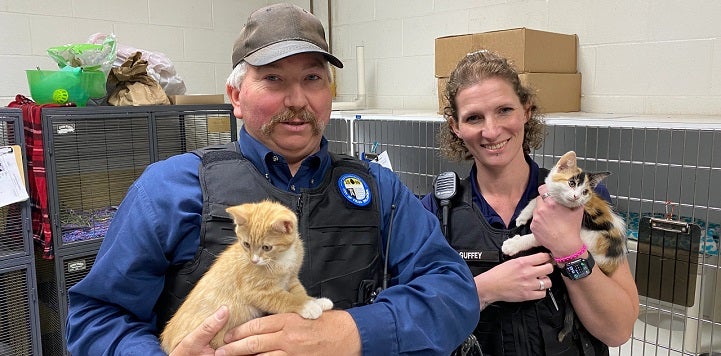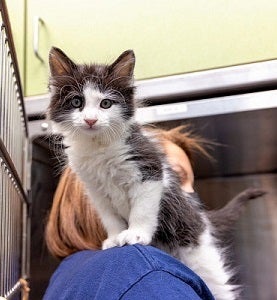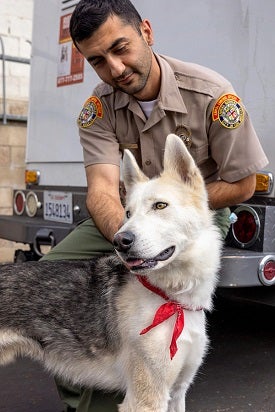
2021 was a challenging year – but it’s not all bad news
The Best Friends national dataset in 2020 was unprecedented, showing progress that astounded even the most optimistic among us. In one year, we transitioned from a nation where 625,000 dogs and cats lost their lives in shelters to one where 347,000 did. We also went from a 79% save rate to an 83% save rate. For all the negatives that come with a pandemic, many of the adjustments animal shelters made during COVID created substantial progress.
While we’ve been seeing data and hearing anecdotes that the post-pandemic reality for shelters in 2021 was not nearly as rosy as it was the year prior, our brand-new dataset drills down into some hard statistics to find out the truth. And yes, we did take a little step backward in terms of lifesaving.
I do mean little, though. The number of animals who didn’t leave shelters alive ticked up by only 2.3% to 355,000 in 2021, which shows that we are trending toward something resembling normality. The latest dataset also shows intake rising by 8.1%. Adoptions grew, but at a slower pace, and this created challenges for shelters – particularly for dogs.
But there’s good news as well. Shelters are reaching (and sustaining) no-kill in larger numbers; three more states are rapidly closing in on the 90% benchmark; and network partners who take advantage of the many benefits of being a partner are seeing many more positive outcomes than shelters that do not.
Even with the slight downturn, we can celebrate the gains being made across the industry and for every animal who comes into our care.
Measuring intakes, outcomes
This year’s dataset includes statistics from more shelters than ever before: We now have data for 80% of the more than 4,000 brick-and-mortar shelters in the country, and an estimated 94% of all sheltered dogs and cats who enter shelters each year.
 As I noted above, the 2021 data reflects a bit of a return toward "normal" after the anomaly of 2020 in which shelters endured long periods of limited public access or even mandated closures during the height of the pandemic. With doors closed to the public and shelters using many strategies to enlist the public’s help, intakes in 2020 dropped by a whopping 20% compared to 2019’s intake figures. It wasn’t surprising, then, to see 2021 shelter intakes go up by 8%. In 2021, a total of 4.6 million pets entered shelters nationally.
As I noted above, the 2021 data reflects a bit of a return toward "normal" after the anomaly of 2020 in which shelters endured long periods of limited public access or even mandated closures during the height of the pandemic. With doors closed to the public and shelters using many strategies to enlist the public’s help, intakes in 2020 dropped by a whopping 20% compared to 2019’s intake figures. It wasn’t surprising, then, to see 2021 shelter intakes go up by 8%. In 2021, a total of 4.6 million pets entered shelters nationally.
With the rise in intake, and the rise in adoptions not keeping pace, we did see a small 2.3% increase in animals killed in shelters. The number of cats dying in shelters continues to outpace dogs at a rate of more than two to one, which underscores the need for organizations of all sizes to implement specific programming. We need shelters and communities to implement TNVR, robust cat adoption programs, and more robust neonatal kitten programs.
Also, interestingly, cat intakes and dog intakes were roughly equal in 2021. We have seen dog intake as a percent of total intake gradually decrease in recent years and this year marks the first year that cats have arrived at shelters in equal numbers. There is also a clear disparity between dog intakes and dog adoptions that has continued into 2022, making it a priority for our industry to figure out new ways of increasing positive canine outcomes.
Ranking statewide progress
As usual, there is a geographic skew to where the biggest lifesaving gap remains. Just five states make up 50% of the national gap to 90%. Texas has the highest number of animals unnecessarily losing their lives, followed by California, North Carolina, Florida and Alabama.
While the numbers look substantially higher in our top five states, it’s important to remember that most of these are states with large populations. With more people come more animals, so it makes sense that they would also have larger shelter populations, and thus more animals potentially at risk.
Speaking of no-kill…
One of the most exciting pieces of data to come out of this year’s collection is that 52% of all shelters have reached no-kill status. That’s up from 48% in 2020 and marks the first time the industry has crested the halfway point. Additionally, the number of counties considered no-kill (in which every shelter in the county has achieved the 90% benchmark) increased by 4%, from 33% in 2020 to 37% in 2021.
It feels like not long ago you could count on one hand the number of communities that were no-kill. But now with more than half of all shelters and more than a third of all counties being no-kill, it feels like there is more momentum than ever.
Every shelter in both New Hampshire and Delaware have maintained their 90% save rates -- allowing both states to be the only two states that are no-kill states. However, three states are close, with a lifesaving gap of less than 100. Vermont has a lifesaving gap of 89 animals, North Dakota’s gap is 41 animals and Rhode Island only needs to save 18 dogs and cats to claim no-kill status.
States, counties and organizations are not just reaching a 90% save rate, they’re consistently sustaining it. More than 90% of all organizations at the no-kill benchmark have maintained their status the following year since 2016.
Counting collaborative impacts
Working together continues to be the hallmark of many shelters achieving increased lifesaving, and we were pleased to see how involvement with Best Friends positively affected the data for many of our network partners. Those who took advantage of one or more of our benefits (e.g., grants, shelter collaborative, shelter embeds, one-on-one consulting) saw results proving the connection between collaboration and success:

- Shelters that engaged with Best Friends in 2021 continued to save lives, reducing the number of dogs and cats killed by 0.1%. The number at unengaged shelters increased by 15.3%.
- Shelters engaged with us decreased the number of cats losing their lives by 2.6%. The number at unengaged shelters increased by 14.6%.
- Engaged shelters reduced the number of cats and dogs entering their doors by 20.7% between 2019 and 2021, compared to 11.9% for unengaged shelters.
In addition, four shelters that worked closely with Best Friends in a variety of ways were able to reduce the number of animals without positive outcomes by more than 1,000. Tangipahoa Parish Animal Control in Hammond, Louisiana; City of Tulsa Animal Welfare; Southeast Area Animal Control Authority in Downey, California; and Los Angeles County Animal Care and Control all made huge strides in 2021.
Summing up our situation
It's never become clearer that shelters benefit from connecting with each other and with the larger national movement. With so many shelters making progress and so many emerging leaders in this field, there are tremendous benefits to connectivity. As we continue to navigate the challenges we face as we get closer to 2025, it's imperative that we continue to work to engage many of the shelters that are not connected to a larger national movement so they too can benefit from shared learning.
Think about it: if we had seen 2021’s upswing in intakes eight years ago, the number of animals not leaving shelters alive would have been much higher – not to mention devastating and deflating. Instead, the data provided by shelters all over the country proves they are working hard and employing innovative strategies to benefit every animal who comes through their doors.
Our industry is also doing a better job of sharing successful strategies with one another so we can learn from each other quickly and solve problems practically in real-time. What we expect of ourselves and our shelters has evolved, and I’m confident that we have the leaders and the community support that we need to make no-kill 2025 happen.
Don’t believe you can truly reach that ambitious goal? Just look at the data. Since we declared our no-kill goal in 2016, 77% fewer dogs and cats have lost their lives. That’s 4.8 million lives spared over five years, and every single one of us has had a hand in that success.

Brent Toellner
Senior director of lifesaving programs
Best Friends Network
If you enjoyed this editorial, you can find our complete catalog of editorials here.